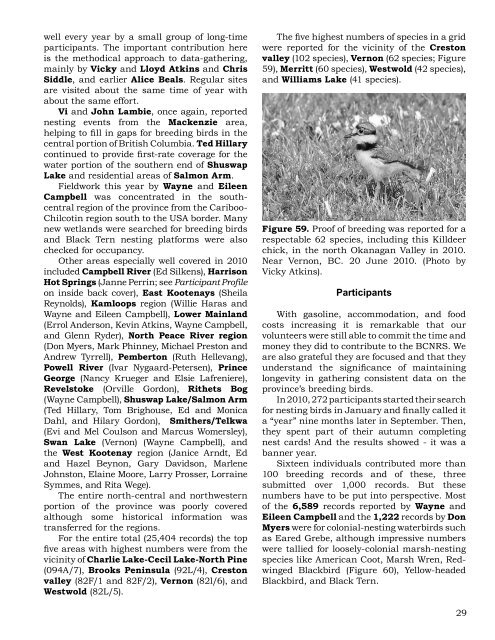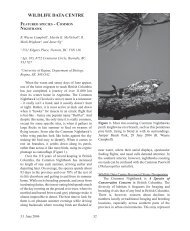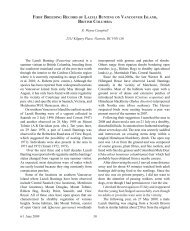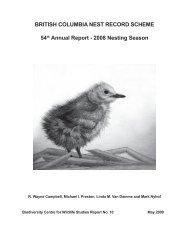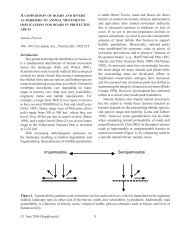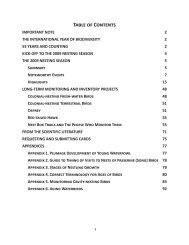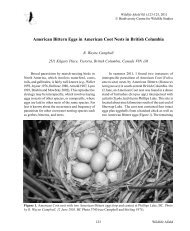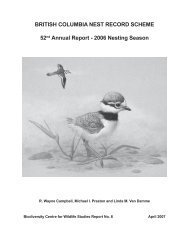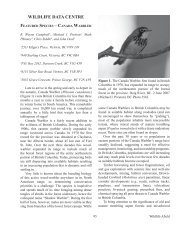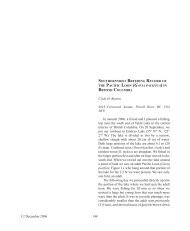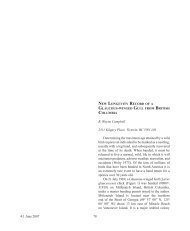2010 Nesting Season - Biodiversity Centre for Wildlife Studies
2010 Nesting Season - Biodiversity Centre for Wildlife Studies
2010 Nesting Season - Biodiversity Centre for Wildlife Studies
Create successful ePaper yourself
Turn your PDF publications into a flip-book with our unique Google optimized e-Paper software.
well every year by a small group of long-time<br />
participants. The important contribution here<br />
is the methodical approach to data-gathering,<br />
mainly by Vicky and Lloyd Atkins and Chris<br />
Siddle, and earlier Alice Beals. Regular sites<br />
are visited about the same time of year with<br />
about the same ef<strong>for</strong>t.<br />
Vi and John Lambie, once again, reported<br />
nesting events from the Mackenzie area,<br />
helping to fill in gaps <strong>for</strong> breeding birds in the<br />
central portion of British Columbia. Ted Hillary<br />
continued to provide first-rate coverage <strong>for</strong> the<br />
water portion of the southern end of Shuswap<br />
Lake and residential areas of Salmon Arm.<br />
Fieldwork this year by Wayne and Eileen<br />
Campbell was concentrated in the southcentral<br />
region of the province from the Cariboo-<br />
Chilcotin region south to the USA border. Many<br />
new wetlands were searched <strong>for</strong> breeding birds<br />
and Black Tern nesting plat<strong>for</strong>ms were also<br />
checked <strong>for</strong> occupancy.<br />
Other areas especially well covered in <strong>2010</strong><br />
included Campbell River (Ed Silkens), Harrison<br />
Hot Springs (Janne Perrin; see Participant Profile<br />
on inside back cover), East Kootenays (Sheila<br />
Reynolds), Kamloops region (Willie Haras and<br />
Wayne and Eileen Campbell), Lower Mainland<br />
(Errol Anderson, Kevin Atkins, Wayne Campbell,<br />
and Glenn Ryder), North Peace River region<br />
(Don Myers, Mark Phinney, Michael Preston and<br />
Andrew Tyrrell), Pemberton (Ruth Hellevang),<br />
Powell River (Ivar Nygaard-Petersen), Prince<br />
George (Nancy Krueger and Elsie Lafreniere),<br />
Revelstoke (Orville Gordon), Rithets Bog<br />
(Wayne Campbell), Shuswap Lake/Salmon Arm<br />
(Ted Hillary, Tom Brighouse, Ed and Monica<br />
Dahl, and Hilary Gordon), Smithers/Telkwa<br />
(Evi and Mel Coulson and Marcus Womersley),<br />
Swan Lake (Vernon) (Wayne Campbell), and<br />
the West Kootenay region (Janice Arndt, Ed<br />
and Hazel Beynon, Gary Davidson, Marlene<br />
Johnston, Elaine Moore, Larry Prosser, Lorraine<br />
Symmes, and Rita Wege).<br />
The entire north-central and northwestern<br />
portion of the province was poorly covered<br />
although some historical in<strong>for</strong>mation was<br />
transferred <strong>for</strong> the regions.<br />
For the entire total (25,404 records) the top<br />
five areas with highest numbers were from the<br />
vicinity of Charlie Lake-Cecil Lake-North Pine<br />
(094A/7), Brooks Peninsula (92L/4), Creston<br />
valley (82F/1 and 82F/2), Vernon (82l/6), and<br />
Westwold (82L/5).<br />
The five highest numbers of species in a grid<br />
were reported <strong>for</strong> the vicinity of the Creston<br />
valley (102 species), Vernon (62 species; Figure<br />
59), Merritt (60 species), Westwold (42 species),<br />
and Williams Lake (41 species).<br />
Figure 59. Proof of breeding was reported <strong>for</strong> a<br />
respectable 62 species, including this Killdeer<br />
chick, in the north Okanagan Valley in <strong>2010</strong>.<br />
Near Vernon, BC. 20 June <strong>2010</strong>. (Photo by<br />
Vicky Atkins).<br />
Participants<br />
With gasoline, accommodation, and food<br />
costs increasing it is remarkable that our<br />
volunteers were still able to commit the time and<br />
money they did to contribute to the BCNRS. We<br />
are also grateful they are focused and that they<br />
understand the significance of maintaining<br />
longevity in gathering consistent data on the<br />
province’s breeding birds.<br />
In <strong>2010</strong>, 272 participants started their search<br />
<strong>for</strong> nesting birds in January and finally called it<br />
a “year” nine months later in September. Then,<br />
they spent part of their autumn completing<br />
nest cards! And the results showed - it was a<br />
banner year.<br />
Sixteen individuals contributed more than<br />
100 breeding records and of these, three<br />
submitted over 1,000 records. But these<br />
numbers have to be put into perspective. Most<br />
of the 6,589 records reported by Wayne and<br />
Eileen Campbell and the 1,222 records by Don<br />
Myers were <strong>for</strong> colonial-nesting waterbirds such<br />
as Eared Grebe, although impressive numbers<br />
were tallied <strong>for</strong> loosely-colonial marsh-nesting<br />
species like American Coot, Marsh Wren, Redwinged<br />
Blackbird (Figure 60), Yellow-headed<br />
Blackbird, and Black Tern.<br />
29


